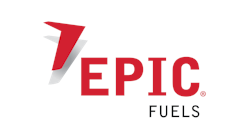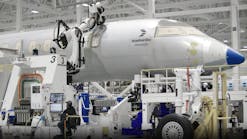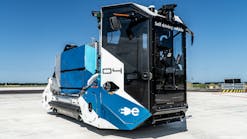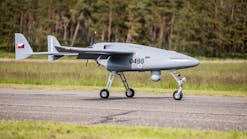It is said that a writer should get the point across within the first sentence or two, so I will: While the industry focus has been primarily on pipelines, anyone who purchases aviation fuel that is delivered by road transport tanker truck that is not ‘grade dedicated’ should read this article very carefully. A recent Joint Inspection Group (JIG) bulletin states, “Jet fuel has been transported in multi-product pipelines for decades. The practice represents an efficient, practical, and environmentally sound option for transporting large volumes of jet fuel over long distances. Quality assurance procedures for handling interfaces between products together with laboratory testing requirements are well established and quality incidents are rare. The introduction of biodiesel into many countries, either by government mandate or customer demand, is challenging this status quo.”
The main issue is that the bio component in biodiesel called FAME (Fatty Acid Methyl Ester) is a surface-active material. In theory, FAME can stick to pipe walls as the biodiesel passes; it then can be removed from the wall and into the fuel grade that follows in the pipeline (which can be jet fuel).
FAME is made from a variety of plant oils (rape, soy, palm, and coconut) and animal fat or tallow. FAME is added to diesel fuel to produce biodiesel and is typically blended in percent quantities at the refinery. Diesel fuel with 2 percent FAME is often called B2; with 5 percent, it is B5; and so on. FAME is added to diesel fuel to comply with renewable fuel mandates that are starting to be imposed across the country as a way to reduce greenhouse gas emissions. FAME is a “non–hydrocarbon” fuel component. The jet fuel specification states that only hydrocarbon components and approved additives are allowed.
FAA Issues a Bulletin
On May 1, 2009 FAA issued a Special Airworthiness Information Bulletin (SAIB: NE-09-25). The bulletin recommends that owners and operators of turbine-engine powered aircraft contact their fuel suppliers to verify they have implemented quality control and inspection procedures to ensure the fuel they deliver does not contain more than 5 ppm of FAME.
In part this FAA bulletin reads:
“The bio-component in biodiesel, FAME, is a surface-active material. This means that in theory, it can adhere to pipe and tank walls as the biodiesel passes through, and then release from the walls into the following product, which may be jet fuel. Also, small amounts of diesel containing FAME remaining within distribution manifolds, tanks, vehicles, and pipes can result in traces of FAME getting into jet fuel transported through the same components. At high enough concentrations, FAME can impact the thermal stability of the fuel that could lead to coke deposits in the fuel system. FAME contamination can also impact the freezing point of jet fuel resulting in gelling of the fuel. These conditions can result in engine operability problems, and possible engine flameout.” [Emphasis added.]
Acceptable level: 5 ppm
Pipeline common carriers are working closely with industry representatives in the United States and in Europe to develop procedures to prevent FAME contamination above the acceptable level of 5 parts per million (ppm). FAA’s SAIB states, “Jet fuel specifications are currently being updated to specify that levels of FAME in jet fuel below the detectable limit of 5 ppm are acceptable. Operation with jet fuel containing more than 5 ppm of FAME would not be in compliance with the aircraft and engine operating limitations, unless approved service information is issued with revised limitations to accommodate FAME levels greater than 5 ppm.”
In the U.K. and Europe, the co-transport of biodiesel and jet fuel in multi-product pipelines is common. So far in the U.S. this is not the case. While the risk of FAME contamination in multi-product pipelines in the U.S. may not be an issue today, government mandates and/or customer demand will likely cause biofuel volumes to grow, increasing the risk of FAME contamination.
One of the major problems for fuel suppliers in assuring jet fuel is free from potential FAME carryover is the lack of widely available testing facilities to measure low-level FAME content. The industry is addressing this issue with a fast track program to develop reliable test methods. But even when these methods are developed, the number of laboratories with the capability to test for FAME content at 5 ppm will be limited.
In the meantime, the approach at Air BP is to follow the guidelines set out in Joint Inspection Group (JIG) Bulletins 15, 16, and 21. We are assessing the potential risk of FAME carryover in all our supply chains and are conducting focused testing. Where investigations suggest that there could be a potential risk of FAME carryover in jet fuel supplies at very low levels, existing and well-established quality assurance procedures are adopted to ensure bulk contamination is below industry-accepted limits. We have adopted these procedures to ensure that all supplies contain less than the current 5ppm max FAME limit.
Industry reaction
The situation is very dynamic and industry is actively working to manage this issue. We are contributing to the development of new test methods and to an industry program that is seeking approval from the aero engine and airframe manufacturers for up to 100 ppm of FAME in jet fuel. Based on existing test results, 100 ppm represents a realistic and achievable level but the approval process will take at least 12 months. In the interim we are working with the OEMs to agree on an emergency protocol to allow fuel with a FAME content greater than 5 ppm to be used to avoid a service disruption at an airport.
Associated risks
The risk of using non-grade dedicated road transports is an issue. While a primary focus has been the risk of FAME contamination during the transport of jet fuel in multi-product pipelines, another serious risk exists in the aviation fuel industry. Some aviation fuel suppliers do not require grade dedicated tanks on road transports. (At a recent road transport carrier forum we asked a group of carriers if they regularly transport biodiesel or other biofuels. Of this group 70 percent answered yes and some stated they transported a grade of biodiesel called B100 which contains 100 percent FAME components.)
It has been our company’s policy that aviation fuel transports be grade dedicated. After the introduction of ultra low sulfur diesel (ULSD) and with the threat of FAME contamination, we are reminding our road transport carriers not to haul jet fuel after biodiesel or ULSD.
We have also advised them that although steam cleaning and drying was an approved procedure prior to hauling aviation fuel, sampling and testing should be done to ensure there is no FAME carryover and that the cleaning procedure was effective. The concern is the fact that FAME is ‘surface active’ and sticks to metal surfaces creating a risk of cross contamination.
To demonstrate this point the JIG Bulletin No. 21 states, “Experience has shown that the practice of three rinses for sample cans does not always remove all traces of FAME and therefore dedicated sample cans and new gloves are simple options to reduce the risk of false alarms.”
Special care must be taken to ensure that if the carrier’s engine driven pump is used to off-load product, it is free of any product remaining from previous use that could contaminate the aviation fuel.
Remember that while the tank may have hauled aviation fuel in previous loads, the pump may have not been used in some time — less than one gallon of B5 in 8,000 gallons of jet fuel will render the fuel off-specification and unfit for use.
An additional risk: ULSD
On the subject of carry-over contamination caused by the use of non-grade dedicated transports, mention needs to be made of the risk posed by the fairly recent introduction of ultra low sulfur diesel — the primary on-road diesel product in the U.S. Not only may ULSD contain up to 5 percent of FAME without any declaration (per ASTM D975), it also contains a lubricity additive found to have the same ‘trail-back’ characteristics as FAME.
As an example, we have worked with large aircraft maintenance and repair facilities that defuel aircraft and have discovered that during the recertification process required to resell the jet fuel, the product was off-spec due to microseparometer (MSEP) test results. We suspect that the root cause was the lubricity additive used in ULSD, which is a strong surfactant. Aircraft don’t use ULSD so we concluded that the source of the contamination was the use of non-grade dedicated transports. A very small amount of biodiesel or ULSD residue left in the tank or sticking to the side — even after cleaning — could cause the jet fuel to be off-spec. Truck pumps, pipes, and hoses are another potential source of cross-contamination from ULSD or FAME.
* * *
How can an operation help ensure that it does not suffer from a FAME-related incident? Talk with the fuel supplier and ask what steps are being taken to address the issue. Check to see if the road transport vehicle delivering the fuel is grade dedicated. During the operation’s next aviation fuel delivery, ask the driver to show the DOT required documentation evidencing the grade of product previously hauled in the tank prior to this aviation fuel delivery.
About the Author
Mike Mooney has served a management role in aviation-related operations including FBOs, airline ground support, into-plane fueling, a corporate flight department, as well as design, installation, and operation of aviation fuel storage systems. A private pilot, he leads the technical & operations function for Air BP.
FBO Snapshots
Odyssey aviation rebuilds at New orleans
Odyssey Aviation is in the midst of constructing a world class jet center at New Orleans Lakefront Airport (KNEW), replacing a facility that was destroyed by Hurricane Katrina in 2005. The former Million Air fixed base operation is expected to open its new complex in late 2009 with hangars to accommodate G-V aircraft, with overflow parking for vehicles and planes. Odyssey Aviation New Orleans is one of seven branded locations owned and operated by the Cincinnati-headquartered FBO group led by Ken Allison, president and CEO.
Western aircraft opens new interior facility
Western Aircraft at Boise’s Gowen Field announces the completion and grand opening of its Interior Re-Completion Center, focusing on major interior refurbishments for large business jets and turboprops. The shop occupies more than 10,000 square feet of storage space. Western Aircraft is an authorized service center, certified aircraft repair station, and worldwide distributor of parts and avionics for OEMs such as Dassault Falcon, Pilatus, Hawker Beechcraft, Honeywell, and Collins.
Western Aircraft has six hangars totaling 120,000 square feet, a 30,000-square foot ramp, and comprehensive line services. Its on-site parts sales department maintains an inventory of over 4,800 line item parts which total $9 million.





